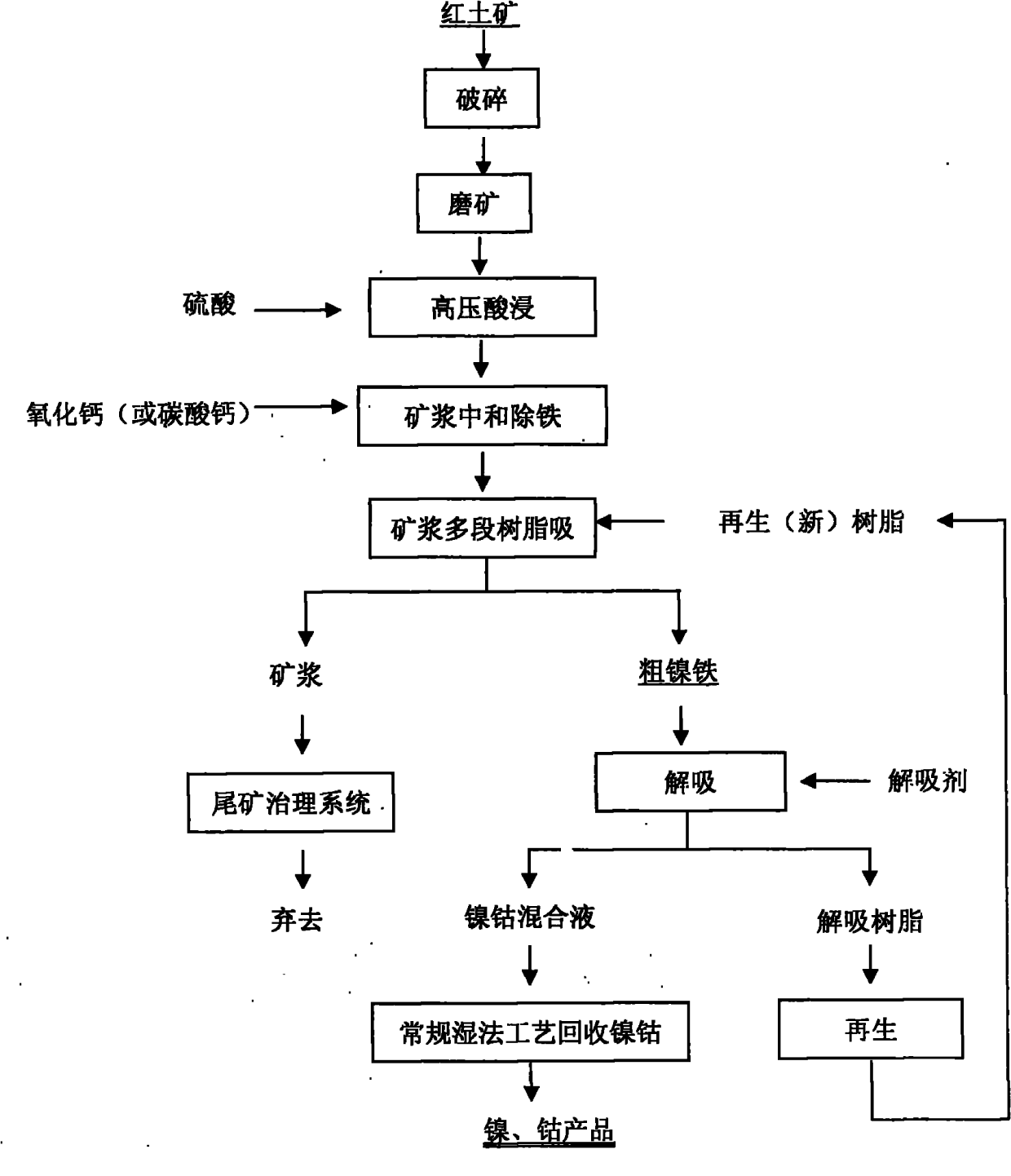Process for extracting nickel-cobalt from laterite by using resin-in-pulp adsorption technology
A resin adsorption and laterite ore technology, applied in the direction of improving process efficiency, can solve the problems of large filtration burden, unrecoverable nickel and cobalt, high sediment viscosity and difficult to wash, etc., to reduce equipment investment, reduce the burden of liquid-solid separation, treatment low cost effect
- Summary
- Abstract
- Description
- Claims
- Application Information
AI Technical Summary
Problems solved by technology
Method used
Image
Examples
Embodiment 1
[0034] a. Take 2000g of laterite ore and crush it to -3mm, add 4000ml of water and grind it with a wet ball mill until the particle size is less than 0.074mm;
[0035] b. Pour the ore slurry after grinding into the autoclave, add 400ml of sulfuric acid solution with a concentration of 10%, stir and leaching for 2h at a temperature of 250°C and a pressure of 4Mpa;
[0036] c. Inject the leached pulp into the normal pressure reactor and add CaCO 3, adjust the pH of the solution to 2.5, and at the same time pass hot air into the blast to oxidize, stir and react for 3 hours, and the temperature is 95°C, so that iron is oxidized to ferric ion hydrolysis and precipitation, and the iron content in the solution after iron removal is less than 5mg / l;
[0037] d. The ore pulp after iron removal is injected into the adsorption tank, and after five-stage countercurrent resin adsorption, the loaded resin is fully extracted from the first-stage adsorption tank for 6 hours, and the subsequen...
Embodiment 2
[0044] a. Take 2000g of laterite ore and crush it to -3mm, add 6000ml of water and grind it with a wet ball mill until the particle size is less than 0.074mm;
[0045] b. The ore slurry after ore grinding is injected into the autoclave, and 500ml of sulfuric acid solution with a concentration of 12% is added, and the temperature is 200°C and the pressure is 3Mpa, and it is stirred and leached for 3h;
[0046] c. Inject the leached ore pulp into the normal-pressure reaction kettle, add CaO, adjust the pH of the solution to 2.0, and at the same time pass hot air into it to oxidize, stir and react for 3 hours, and the temperature is 95°C to oxidize iron into ferric ions and hydrolyze and precipitate. The iron content in the solution after iron removal is less than 5mg / l;
[0047] d. The ore pulp after iron removal is injected into the adsorption tank, and after six-stage countercurrent resin adsorption, the loaded resin is fully extracted from the first-stage adsorption tank for ...
Embodiment 3
[0054] a. Take 2000g of laterite ore and crush it to -3mm, add 8000ml of water and grind it with a wet ball mill until the particle size is less than 0.074mm;
[0055] b. The ore slurry after ore grinding is injected into the autoclave, and 600ml of sulfuric acid solution with a concentration of 15% is added, and the temperature is 300°C and the pressure is 5Mpa, and it is stirred and leached for 4h;
[0056] c. Inject the leached ore slurry into the normal pressure reactor, add Na 2 CO 3 , adjust the pH of the solution to 4.5, and at the same time pass hot air into the blast to oxidize, stir and react for 3 hours, and the temperature is 98°C, so that iron is oxidized to ferric ion hydrolysis and precipitation, and the iron content in the solution after iron removal is less than 5mg / l;
[0057] d. The ore pulp after iron removal is injected into the adsorption tank, and after seven-stage countercurrent resin adsorption, the loaded resin is fully extracted from the first-stage...
PUM
| Property | Measurement | Unit |
|---|---|---|
| particle size | aaaaa | aaaaa |
Abstract
Description
Claims
Application Information
 Login to View More
Login to View More - R&D
- Intellectual Property
- Life Sciences
- Materials
- Tech Scout
- Unparalleled Data Quality
- Higher Quality Content
- 60% Fewer Hallucinations
Browse by: Latest US Patents, China's latest patents, Technical Efficacy Thesaurus, Application Domain, Technology Topic, Popular Technical Reports.
© 2025 PatSnap. All rights reserved.Legal|Privacy policy|Modern Slavery Act Transparency Statement|Sitemap|About US| Contact US: help@patsnap.com


